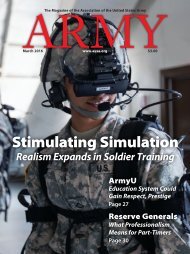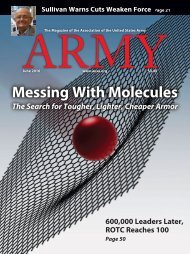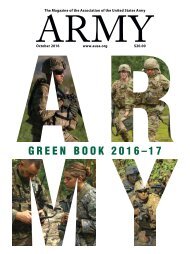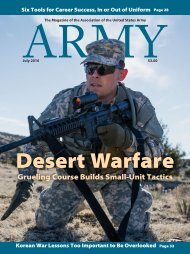Army - The New Germ War
You also want an ePaper? Increase the reach of your titles
YUMPU automatically turns print PDFs into web optimized ePapers that Google loves.
U.S. <strong>Army</strong>/Maj. Randy Ready<br />
Soldiers from the 7th Infantry Regiment fire an M1A2 Abrams tank at Grafenwoehr Training Area, <strong>Germ</strong>any.<br />
Early program descriptions noted that the <strong>Army</strong> had developed<br />
a conceptual technical data package “for informational<br />
purposes.” McFarland credited the U.S. <strong>Army</strong> Armament<br />
Research, Development and Engineering Center for developing<br />
the concept.<br />
“We made that technical data available to the contractors,<br />
but they are not required to use it,” he said. “<strong>The</strong>y are completely<br />
open to propose their own designs for the state of the<br />
competition.”<br />
Planned acquisition includes a two-phased engineering and<br />
manufacturing development (demonstration phase I and completion<br />
phase II, a low-rate initial production phase and two<br />
full-rate production options). Full-rate production is estimated<br />
at approximately 3,500 cartridges per year.<br />
Shortly before the Association of the U.S. <strong>Army</strong>’s Annual<br />
Meeting and Exposition last October, the <strong>Army</strong> awarded<br />
XM1147 engineering and manufacturing development phase I<br />
contracts to Orbital ATK and General Dynamics Ordnance<br />
and Tactical Systems.<br />
“Our ammunition innovations like advanced kinetic energy<br />
penetrators and airbursting munitions are providing<br />
combat overmatch for our warfighters—which is our company’s<br />
mission,” said Dan Olson, vice president and general<br />
manager for Orbital ATK’s Armament Systems division of<br />
the Defense Systems Group. Pointing to the company’s recent<br />
qualification of the M829A4 fifth-generation kineticenergy<br />
round, he said, “Our ability to innovate comes from<br />
a long history of creating new capabilities for existing systems<br />
through our expertise in fuzing, warheads and platform<br />
integration.”<br />
In his own AUSA booth briefing, Emil Kovalchik, senior<br />
director of marketing and business development for General<br />
Dynamics Ordnance and Tactical Systems, highlighted a<br />
predecessor 120 mm Multi-Purpose High Explosive Round<br />
fielded on an urgent basis by the U.S. Marine Corps.<br />
“<strong>The</strong>y actually did that directly with Rheinmetall [round designation<br />
DM11], who is our partner in Defense Munitions International,”<br />
Kovalchik said. “We got pulled in after they started<br />
building those for the Marines. But we’ve gotten extraordinary<br />
results.”<br />
Kovalchik said the multipurpose high explosives were fired<br />
“in combat in Afghanistan—we had Marine Corps tanks<br />
there—and we got great feedback from the Marines. So the<br />
task before us under the AMP process is to pretty much<br />
‘Americanize it,’ if you will.”<br />
“By doing that, basically we’re going to simplify the design,”<br />
he said. “We’re looking at materials that we might be able to<br />
substitute” to make it more competitive and a better value.<br />
<strong>The</strong> new AMP “takes out the guesswork,” and makes the<br />
Abrams crew “much more effective on target in almost all<br />
cases,” Kovalchik said.<br />
“And those targets are everything from lightly skinned vehicles,<br />
anti-aircraft type targets, manmade bunkers, troops in the<br />
open and concrete walls,” he said. “So one round does it all<br />
and ultimately makes the soldier or Marine on the battlefield<br />
that much safer—not having to go through the situation<br />
where they have a particular target that they can’t service. So<br />
it’s a great, great idea that is more than past its time.”<br />
Pointing to the current development program, McFarland<br />
said the <strong>Army</strong> would down-select to one of the two independent<br />
designs during the first quarter of 2017 based on demonstrated<br />
performance and cost.<br />
“We expect that in the January to February time frame,” he<br />
said. “From there, we’ll complete development with one contractor,<br />
finalize the design, qualify it, and get it through operational<br />
testing and out into the field” in fiscal year 2021.<br />
“I think the takeaway is that in conjunction with the Abrams<br />
platform, we are providing the soldiers with additional capabilities<br />
as well as making their lives better by reducing their battlecarry<br />
dilemma,” McFarland said, “and in saving them precious<br />
seconds in the direct firefight in contact with the enemy.” ✭<br />
60 ARMY ■ September 2016

















